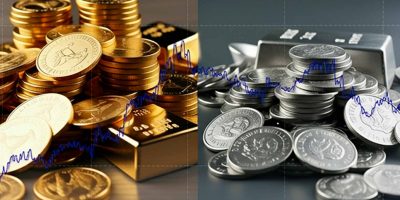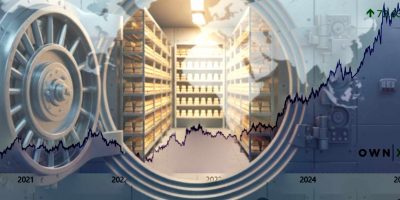Gold and the U.S. dollar move in opposite directions. When one rises, the other often falls. This happens because gold is priced in dollars, and changes in the dollar’s value affect gold prices.
Gold prices have recently surged to all-time highs, fueled by increasing political and economic uncertainty. Global conflicts, trade tensions, and major shifts in U.S. policy have driven investors toward gold as a safe-haven asset. Central banks, particularly in emerging markets, are increasing gold reserves to reduce reliance on the U.S. dollar, strengthening demand.
The rapid pace of U.S. policy changes, including speculation about tariffs on gold and potential audits of Fort Knox and the Federal Reserve, has contributed to this surge. A notable increase in physical gold repatriation to the U.S. also signals rising concerns over global financial stability.
As inflation remains unpredictable and monetary policies shift, the relationship between gold and the dollar remains key to financial stability. This article explores how these forces interact and why gold continues to
| Key Takeaways |
|---|
| Gold and the U.S. dollar move in opposite directions, influencing global markets and investment strategies. |
| In 2025, gold has reached $4,358.50 per ounce due to Federal Reserve rate cut expectations, economic instability, and geopolitical risks. |
| Central banks, including China, Poland, and Turkey, are aggressively increasing gold reserves to reduce reliance on the U.S. dollar. |
| Financial uncertainty, shifting monetary policies, and inflation concerns are driving strong gold demand worldwide. |
| Now is a great time to buy gold as prices continue to rise amid ongoing global and economic uncertainty. |
| OWNx provides a secure, hassle-free way to invest in gold through fractional ownership, making gold accessible to all investors. |
The Relationship Between Gold and the Dollar
Gold and the dollar have a long history of moving in opposite directions. When the dollar gains strength, gold prices tend to fall. When the dollar weakens, gold prices usually rise. This inverse relationship happens because gold is priced in dollars on global markets.
When the dollar is strong, it takes more foreign currency to buy gold, making it less attractive for international investors. A weaker dollar makes gold more affordable, increasing demand and pushing prices higher.
For example, in 2008, during the financial crisis, the dollar weakened, and gold prices surged. In 2020, uncertainty caused by the “pandemic” pushed gold to record highs.
More recently, in 2024, gold surged past $2,400 per ounce, driven by expectations of Federal Reserve rate cuts and geopolitical risks. The rapid policy shifts under the new U.S. administration have introduced new uncertainty, with analysts watching for potential financial disruptions. The weakening U.S. dollar continues to push demand for gold as a hedge against economic risks.
How Gold Prices React to the Economy
Gold prices change based on economic conditions. Inflation, recession, and uncertainty all play a role in how much gold is worth.
When inflation rises, the dollar loses value, and people turn to gold to protect their money. This increased demand pushes prices higher. With ongoing concerns about inflation and shifting U.S. economic policies, analysts believe gold prices will continue climbing, reinforcing its role as a hedge against currency devaluation.
Recessions also affect gold. When the economy slows, stocks often drop, and investors look for safer places to put their money. Gold holds its value even when other investments lose money. With concerns over economic instability and expected interest rate cuts, gold is performing well in 2025, though its long-term trajectory remains uncertain.
In early 2024, gold prices jumped after U.S. inflation came in higher than expected, confirming its role as a hedge against rising prices. Analysts at JPMorgan have noted that gold’s link to interest rates has strengthened, meaning Federal Reserve decisions will play a major role in price movements. As uncertainty over monetary policy grows, many investors are increasing their gold holdings to protect their wealth.
Economic Uncertainty and Gold Demand
Gold is a go-to investment when the world feels unstable, especially as geopolitical tensions, trade disputes, and economic uncertainty continue to unsettle global markets. When financial markets become risky, gold demand rises because it holds its value while stocks and currencies drop.
Major policy shifts, including speculation about tariffs and economic restructuring, have contributed to growing concerns over global stability. In 2024 and 2025, these factors, alongside escalating global tensions, have helped gold prices reach new highs. Many experts predict that as long as uncertainty remains, demand for gold will stay strong. According to the World Gold Council, central banks purchased over 1,000 metric tons of gold in 2024, the highest level in over a decade, reinforcing gold’s role as a key asset in uncertain times.
Market trends also affect gold. If investors worry about the economy, they shift their money into gold, pushing prices up. Even speculation about policy changes can drive demand higher. With ongoing market swings, gold remains a smart investment for anyone looking to protect their money.
Central Banks and Their Influence on Gold and the Dollar
Central banks play a crucial role in the relationship between gold and the dollar. They hold large gold reserves and use them to manage currency values and economic stability.
When central banks buy gold, demand increases, driving up prices. When they sell gold, supply increases, pushing prices down. Countries like China, Russia, and India have increased their gold reserves in recent years to reduce dependence on the U.S. dollar and hedge against global financial uncertainty.
“Central banks, particularly in countries like Russia, China, India and Turkey, have dramatically increased their gold purchases, reflecting growing mistrust in the US dollar. This trend is further fuelled by the countries accelerating their efforts towards de-dollarization.”
– Anita Wright, independent financial adviser at Bolton James.
Monetary policy decisions also affect gold prices. The Federal Reserve’s stance on interest rates and the uncertainty surrounding potential audits of Fort Knox and the Fed have contributed to rising demand for gold. Some analysts speculate that central banks are increasing gold reserves in response to these concerns.
For example, when the Federal Reserve cut interest rates in response to economic slowdowns, gold prices climbed. Low interest rates weaken the dollar, making gold a stronger investment. With current policy shifts and ongoing economic uncertainty, central banks are expected to remain key players in the gold market.
The Dollar Index and Gold’s Movement
The Dollar Index (DXY) measures the strength of the U.S. dollar against a basket of major currencies. Gold prices often move in the opposite direction of this index because a stronger dollar makes gold more expensive for international investors, reducing demand, while a weaker dollar makes gold cheaper, driving prices higher.
Recent trends have reinforced this inverse relationship. In 2024, the Dollar Index fluctuated significantly due to changing Federal Reserve interest rate expectations and global economic concerns. For example, when the index rose above 105 in early 2024, gold prices briefly declined. However, as inflation concerns and expectations of rate cuts increased later in the year, the dollar weakened, and gold surged past $2,400 per ounce.
The rapid pace of policy changes in the U.S. has added to this volatility, with analysts debating the long-term impact on the dollar. Tracking the Dollar Index helps investors predict potential gold price movements. A strong dollar can put pressure on gold, while a weakening dollar often signals a rise in gold prices. With ongoing economic and geopolitical uncertainty, experts suggest that gold’s upward trend could continue, though future price movements remain uncertain.
Interest Rates and Gold’s Value
Interest rates have a direct impact on both the dollar and gold prices. When interest rates rise, investors earn higher returns on savings accounts, bonds, and other fixed-income investments. This makes gold less attractive because it doesn’t generate interest.
Higher interest rates strengthen the dollar by attracting foreign investment. A strong dollar then reduces gold demand, pushing prices down.
When interest rates fall, the opposite happens. Investors look for alternative stores of value, and gold demand increases. A weaker dollar makes gold more appealing, driving prices higher.
The Federal Reserve plays a key role in setting interest rates. In 2018, the Fed raised rates multiple times, strengthening the dollar and causing gold prices to decline. In 2020, the Fed cut rates to near zero, weakening the dollar and boosting gold prices. Now, with rapid shifts in U.S. policy and speculation about economic restructuring, investors are watching the Fed’s next moves closely, as uncertainty continues to push demand for gold higher.
The Gold Standard: When Gold Backed the Dollar
For much of history, gold and the U.S. dollar were directly linked. Under the gold standard, every U.S. dollar was backed by a fixed amount of gold. This meant people could exchange dollars for physical gold, keeping the currency stable.
However, this system had limitations. During economic crises, governments needed more flexibility to print money and stimulate growth. In 1971, the U.S. ended the gold standard, making the dollar a fiat currency—one backed by government trust rather than gold.
If the U.S. returned to the gold standard today, it would severely limit how much money could be in circulation. The economy would struggle to grow, and financial markets would become more rigid. Most experts agree that the modern financial system works better without a direct gold backing.
If the U.S. returned to the gold standard today, it would severely limit how much money could be in circulation. The economy would struggle to grow, and financial markets would become more rigid. While a return to the gold standard remains unlikely, increasing global gold reserves and ongoing discussions about Fort Knox audits suggest that trust in fiat currency is not absolute.
Financial Analysis: Comparing Gold and the Dollar Over Time
Gold and the dollar have moved in opposite directions for decades. Looking at historical data, gold prices tend to rise during periods of dollar weakness and inflation. For example:
- 1970s: High inflation caused gold prices to surge as the dollar lost value.
- 1980s–1990s: Strong economic growth and rising interest rates strengthened the dollar, keeping gold prices lower.
- 2008 Financial Crisis: The dollar weakened, and gold hit record highs as investors sought safety.
- 2020 Pandemic: Massive stimulus spending weakened the dollar, pushing gold to new peaks.
- 2024–2025: Geopolitical conflicts, rising central bank gold reserves, and economic uncertainty have driven gold prices to record highs above $2,400 per ounce. With expectations of Federal Reserve rate cuts, increasing repatriation of physical gold, and continued global instability, many investors see gold as a necessary hedge against financial uncertainty.
Long-term trends show that gold protects purchasing power when the dollar loses value. While the dollar remains the world’s leading currency, history suggests that political instability, economic shocks, and inflation can reduce its strength, reinforcing gold’s appeal as financial insurance.
An International Review: Gold and the Dollar’s Role in Global Markets
The U.S. dollar dominates global trade, but many countries are shifting toward gold. Central banks in China, Russia, and India have increased their gold reserves to reduce reliance on the dollar. This trend highlights gold’s lasting appeal as a global store of value.
Some nations are also exploring alternative currencies for trade, reducing dependence on the U.S. dollar. If this trend continues, it could increase gold’s importance as a hedge against currency instability. In 2024, China and Russia ramped up efforts to settle international trade in gold and local currencies, signaling a shift in global financial structures.
Gold plays a critical role in foreign exchange reserves—assets that governments hold to stabilize their economies. A growing number of countries see gold as a way to strengthen their financial systems, ensuring stability in uncertain times.
Some nations are also exploring alternative currencies for trade, reducing dependence on the U.S. dollar. In 2024, China and Russia ramped up efforts to settle international trade in gold and local currencies, signaling a shift in global financial structures. At the same time, central banks in emerging markets have continued accumulating gold at record levels, citing concerns about U.S. monetary policy shifts and global economic stability.
Gold plays a critical role in foreign exchange reserves—assets that governments hold to stabilize their economies. As confidence in fiat currencies faces renewed scrutiny, gold is increasingly viewed as a safeguard against potential financial disruptions.
Exchange Rates and Their Link to Gold Prices
Currency exchange rates affect gold demand. When the U.S. dollar strengthens against other major currencies, gold becomes more expensive for foreign buyers. This can lead to lower demand and a dip in gold prices.
Conversely, when the dollar weakens, gold becomes cheaper for international investors, boosting demand. This is why gold is often viewed as a global currency and a hedge against financial instability—its value remains recognized regardless of national economies.
In some cases, currency crises can drive gold demand. When countries experience rapid inflation or political instability, people turn to gold as a way to preserve wealth. In these situations, gold can act as an emergency form of money.
In some cases, currency crises can drive gold demand. When countries experience rapid inflation, policy shifts, or political instability, people turn to gold to preserve their wealth. The recent surge in central bank gold purchases reflects this growing concern, as governments seek alternatives to reliance on traditional fiat systems. In these situations, gold can act as an emergency form of money and a long-term store of value.
Conclusion
Gold and the dollar share a complex, yet predictable, relationship. When the dollar strengthens, gold prices usually fall. When the dollar weakens, gold demand rises. This dynamic plays a key role in investment strategies, central bank policies, and global financial markets.
With gold hitting record highs in 2024 and central banks increasing their gold reserves, now is a strong time for investors to consider adding gold to their portfolios. Analysts predict that ongoing economic and geopolitical uncertainty will continue driving demand, making gold a reliable store of value and an important hedge against inflation and currency fluctuations.
With gold hitting record highs in 2024 and central banks increasing their gold reserves, investors are turning to gold as a hedge against financial uncertainty and shifting monetary policies. Analysts suggest that ongoing geopolitical risks, Federal Reserve decisions, and global economic instability will continue driving demand, reinforcing gold’s role as a reliable store of value.
OWNx provides a simple and secure way to invest in gold. With fractional ownership, investors can buy gold without the hassle of storing physical bars or coins. As gold continues to rise in value, OWNx offers an easy way to protect wealth and benefit from gold’s stability in an unpredictable financial landscape.
Staying informed about gold-dollar trends is crucial for making smart investment decisions. Whether for diversification or wealth protection, gold remains a critical asset in today’s volatile and rapidly changing global financial system.
FAQs
How does investor sentiment affect gold prices?
When investors worry about inflation or market instability, gold demand rises as a safe-haven asset.
Why are precious metals like gold considered a strong investment?
Gold and other precious metals hold value over time, protecting wealth against inflation and currency devaluation.
What is the gold-dollar relationship?
Gold and the U.S. dollar have an inverse relationship—when the dollar weakens, gold prices tend to rise.
Why is gold investing popular during economic uncertainty?
Gold provides stability when stocks and currencies become volatile, making it a key asset for risk-averse investors.
How does the inverse relationship between gold and the U.S. dollar impact prices?
A stronger U.S. dollar makes gold more expensive for foreign buyers, reducing demand and contributing to lower gold prices, while a weaker dollar drives gold prices higher
Are exchange-traded funds (ETFs) a good way to invest in gold?
Yes, gold ETFs allow investors to gain exposure to gold’s price movements without needing to store physical metal.







